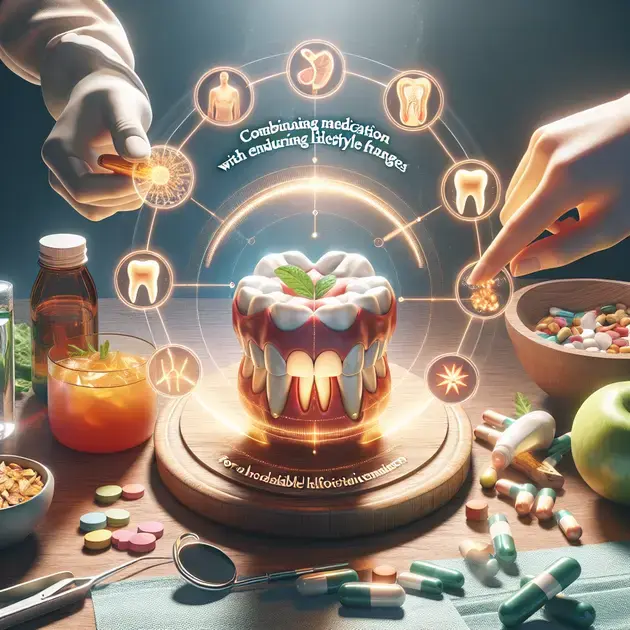Periodontitis, a severe gum infection that damages the soft tissue and destroys the bone that supports your teeth, can lead to tooth loss if left untreated. In addition to professional dental treatments, such as scaling and root planing, effective medication options play a crucial role in managing this condition.
Recent studies have shown promising results in the use of antibiotics, such as doxycycline and minocycline, to help control the bacteria that contribute to periodontitis. These medications can be used in conjunction with traditional therapies to improve outcomes and promote better oral health.

The Benefits of Antibiotics in Treating Periodontitis
Periodontitis, a severe gum infection that damages the soft tissue and destroys the bone that supports your teeth, can be effectively treated with the use of antibiotics. Antibiotics work by targeting and eliminating the bacteria causing the infection, helping to reduce inflammation and stop the progression of periodontitis.
One of the main benefits of antibiotics in treating periodontitis is their ability to reach deep into the infected pockets in your gums, where it may be difficult for traditional therapies to penetrate. This targeted approach helps to combat the bacteria at the root of the infection, promoting healing and preventing further damage to your oral health.
To maximize the benefits of antibiotics in treating periodontitis, it is essential to follow your dentist’s prescribed treatment plan carefully. This may involve taking the medication for a specific duration, alongside maintaining good oral hygiene practices such as brushing and flossing regularly.
If you are unsure about the use of antibiotics for treating periodontitis, consult with your dentist or periodontist to discuss the potential benefits and risks associated with this treatment option. They can provide you with personalized recommendations based on your individual oral health needs.
Combining Medication with Traditional Therapies for Better Results
For enhanced effectiveness in managing periodontitis, combining antibiotic medication with traditional therapies such as scaling and root planing can yield better results. Scaling and root planing involve deep cleaning of the teeth and roots to remove plaque and tartar buildup, which can help create a healthier environment for antibiotic treatment to work optimally.
To combine medication with traditional therapies for better results in treating periodontitis, your dentist may create a customized treatment plan that integrates both approaches. This comprehensive strategy targets the infection from multiple angles, increasing the likelihood of successful outcomes and improved oral health.
It is important to adhere to the recommended follow-up appointments and maintenance routines outlined by your dental professional when combining medication with traditional therapies. Regular monitoring and adjustments to your treatment plan may be necessary to ensure the best possible results in managing periodontitis over time.
By synergizing antibiotic medication with traditional therapies, patients with periodontitis can benefit from a comprehensive treatment approach that addresses both the symptoms and underlying causes of the infection. This integrated strategy can lead to more effective healing and long-term management of the condition.
Promising Results: Doxycycline and Minocycline in Managing Periodontitis
Doxycycline and minocycline are two types of antibiotics that have shown promising results in managing periodontitis. These medications are often prescribed in conjunction with other treatments to target specific strains of bacteria known to contribute to gum disease and periodontal infections.
When using doxycycline and minocycline in managing periodontitis, it is essential to follow the dosage instructions provided by your dentist or healthcare provider carefully. These antibiotics work best when taken consistently and as directed, to ensure optimal effectiveness in combating the infection and promoting gum health.
Studies have indicated that the use of doxycycline and minocycline can help reduce inflammation, improve gum tissue attachment to the teeth, and enhance overall periodontal health. These antibiotics have demonstrated efficacy in controlling the progression of periodontitis and supporting the healing process.
Patients interested in exploring the potential benefits of using doxycycline and minocycline for managing periodontitis should consult with their dentist to determine the most appropriate treatment plan for their individual needs. Your dental professional can provide guidance on the use of these antibiotics as part of a comprehensive approach to treating gum disease and restoring oral health.

**Combining Medication with Lifestyle Changes for Lasting Periodontitis Relief**
Introduction
Periodontitis is a chronic inflammatory condition that affects the gums and bone supporting the teeth, leading to symptoms such as gum recession, bleeding, and in severe cases, tooth loss. While medication can help in managing the symptoms, combining it with lifestyle changes can offer more lasting relief. This approach focuses on addressing the root cause of periodontitis and improving overall oral health.
Benefits of Combining Medication with Lifestyle Changes
By combining medication with lifestyle changes, patients can experience improved gum health, reduced inflammation, and better overall oral hygiene. Lifestyle changes such as quitting smoking, adopting a balanced diet rich in vitamins and minerals, and practicing proper oral hygiene can complement the effects of medication and promote long-term relief from periodontitis symptoms.
Implementing Lifestyle Changes
Patients can work closely with their healthcare providers to develop a tailored plan that includes medication and lifestyle changes. This may involve regular dental check-ups, professional cleanings, and personalized recommendations for diet and oral care habits. Making small but impactful changes in daily routines can have a significant impact on managing periodontitis.
Monitoring Progress and Adjusting Treatment
Regular monitoring of the treatment plan is essential to track progress and make necessary adjustments. Healthcare providers can assess the effectiveness of medication and lifestyle changes, make recommendations for improvements, and address any concerns or complications that may arise during the course of treatment. Open communication between patients and healthcare providers is key to achieving lasting relief from periodontitis.
Embracing a Holistic Approach
Combining medication with lifestyle changes for periodontitis relief reflects a holistic approach to oral health. By addressing both the symptoms and underlying causes of the condition, patients can experience comprehensive care that promotes healing and long-term wellbeing. This integrative approach empowers individuals to take control of their oral health and make positive changes that can lead to lasting relief from periodontitis.
**
Conclusion
**
In conclusion, the holistic approach of combining medication with lifestyle changes for lasting periodontitis relief offers significant benefits for patients. By addressing both the symptoms and root causes of periodontitis, individuals can achieve improved gum health, reduced inflammation, and better overall oral hygiene. This integrative strategy not only focuses on managing the condition but also empowers patients to take control of their oral health.
Implementing lifestyle changes, such as quitting smoking, following a balanced diet, and maintaining proper oral hygiene practices, can complement the effects of medication and promote long-term relief from periodontitis symptoms. Working closely with healthcare providers to develop personalized plans and regularly monitoring progress are key aspects of this approach, ensuring that adjustments can be made as needed for optimal results.
Embracing a holistic approach to oral health not only promotes healing but also fosters long-term wellbeing. By embracing the combination of medication and lifestyle changes, individuals can experience comprehensive care that addresses the condition from multiple angles. This approach encourages open communication between patients and healthcare providers, facilitating a collaborative effort towards achieving lasting relief from periodontitis and promoting a healthier oral environment.



